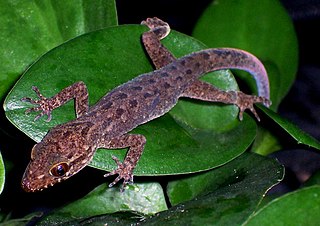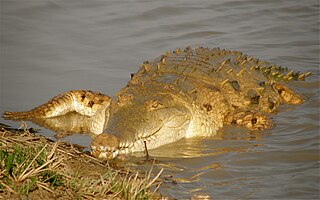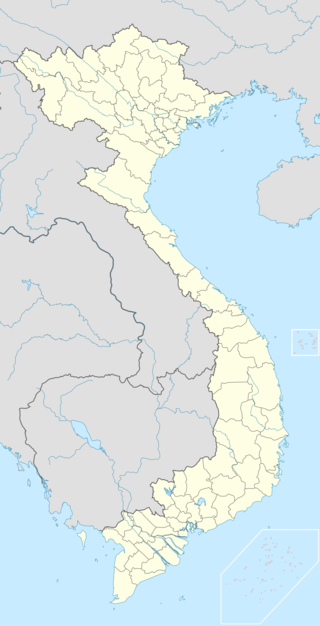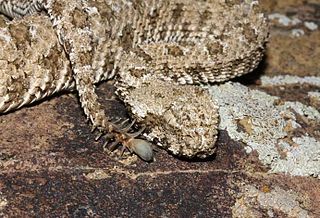
Acinonyx is a genus within the Felidae family. The only living species of the genus, the cheetah, lives in open grasslands of Africa and Asia.

The earless monitor lizard is a semiaquatic, brown lizard native to the Southeast Asian island of Borneo. It is the only living species in the family Lanthanotidae and it is related to the true monitor lizards.

Cyrtodactylus is a diverse genus of Asian geckos, commonly known as bent-toed geckos, bow-fingered geckos, and forest geckos. The genus has 354 described species as of 2023, which makes it the largest of all gecko genera.

Acanthosaura is a genus of lizards, commonly known as mountain horned dragons or pricklenape agamas, in the family Agamidae. The common name "pricklenape" refers to a row of dorsal spines which runs down the back of the neck. They are arboreal lizards found in Southeast Asia. They are medium-sized, their total length ranging from about 7.5 to 15 in, depending on species and individual. As the common name "mountain horned dragons" implies, they tend to prefer higher elevation areas with dense vegetation.

Physignathus cocincinus is a species of agamid lizard native to southern China and mainland Southeast Asia. It is commonly known as the Chinese water dragon, Indochinese water dragon, Asian water dragon, Thai water dragon, or green water dragon.

The Orinoco crocodile is a critically endangered crocodile. Its population is very small, and they can only be found in the Orinoco river basin in Venezuela and Colombia. Extensively hunted for their skins in the 19th and 20th centuries, it is one of the most endangered species of crocodiles. It is a very large species of crocodilian; males have been reported up to 6.8 m in the past, weighing over 900 kg (2,000 lb), but such sizes do not exist today, 5.2 m being a more widely accepted maximum size. A large male today may attain 4.2 m in length and can weigh up to 450 kg (1,000 lb), while females are substantially smaller with the largest likely to weigh around 225 kg (496 lb). Sexual dimorphism is not as profound as in other crocodilian species. The coloration is light even in adults.

The Hershkovitz's marmoset, also known as the Aripuanã marmoset is a marmoset species endemic to the south-central Amazon rainforest in Brazil. The common name is a reference to American zoologist Philip Hershkovitz.

Rhacophorus is a genus of frogs in the shrub-frog family Rhacophoridae, which, with the related Hylidae, is one of the two genera of true tree frogs. They are found in China, India, Japan, and throughout Southeast Asia, including the island of Borneo. Over 40 species are currently recognised.
David Burton Wake was an American herpetologist. He was professor of integrative biology and Director and curator of herpetology of the Museum of Vertebrate Zoology at the University of California, Berkeley. Wake is known for his work on the biology and evolution of salamanders as well as general issues of vertebrate evolutionary biology. He has served as president of the Society for the Study of Evolution, the American Society of Naturalists, and American Society of Zoologists. He was a member of the American Association for the Advancement of Science, the Linnean Society of London, the American Academy of Arts and Sciences, the American Philosophical Society, and in 1998 was elected into the National Academy of Sciences. He was awarded the 2006 Leidy Award from the Academy of Natural Sciences of Philadelphia.

The rare skate, also known as the blue skate, is the largest skate in the world, attaining a length of up to 2.85 m. Historically, it was one of the most abundant skates in the northeast Atlantic Ocean and the Mediterranean Sea. Despite its name, today it appears to be absent from much of this range. Where previously abundant, fisheries directly targeted this skate and elsewhere it is caught incidentally as bycatch. The species was uplisted to critically endangered on the IUCN Red List in 2006 and it is protected within the EU.

Neurergus derjugini, the Kurdistan newt, Kordestan newt, Derjugin's (Kordestan) mountain newt, or yellow-spotted mountain newt, is a species of salamander in the family Salamandridae. It is found in Kurdistan in western Iran and in northeastern Iraq. There are two subspecies, Neurergus derjugini derjugini and Neurergus derjugini microspilotus, the latter is sometimes known as the Avroman Dagh newt.

The white-spectacled warbler is a species of leaf warbler in the family Phylloscopidae. It is found in Asia from the eastern Himalayas to south-eastern China and southern Vietnam. Its natural habitats are subtropical or tropical moist lowland forests and subtropical or tropical moist montane forests. It was formerly included in the Old World warbler family, Sylviidae.

Flueggea, the bushweeds, is a genus of shrubs and trees in the family Phyllanthaceae first described as a genus in 1806. It is widespread across much of Asia, Africa, and various oceanic islands, with a few species in South America and on the Iberian Peninsula.

Vampyrius vampyrus is a medium-sized species of flying frogs endemic to Vietnam. It is found in southern Vietnam, and is not known to be found in other places globally. It Is in the kingdom Animalia, phylum Chordata, and class Amphibia. Along with this, it is in the order Anura, family Rhacophoridae, and it is the only member of the genus Vampyrus. It is also known as the vampire tree frog or the vampire flying frog because of the presence of a pair of fang-like hooks in the mouth of the tadpoles.

The spider-tailed horned viper is a species of viper, a venomous snake, in the family Viperidae and genus Pseudocerastes. The genus is commonly known as "false-horned vipers".
Trimeresurus arunachalensis, the Arunachal pitviper, is a species of venomous pit viper endemic to the Indian state of Arunachal Pradesh. It is only known from the village of Ramda in the West Kameng district, where a single specimen was discovered during biodiversity surveys. It can physically be distinguished by its scalation, its acutely pointed snout reminiscent of the hump-nosed viper, and its brownish dorsal coloration with glossy orange-reddish-brown sides and belly. The last new species of (green) pit viper was described from India 70 years before the discovery of T. arunachalensis. Genetic analysis indicates that the closest relative of this species is the Tibetan bamboo pit viper. The single specimen known of this species makes it one of the rarest known pit vipers in the world, though further surveys of the forest habitat will likely reveal more individuals.

Varanus darevskii, also known as the Central Asian monitor, is an extinct species of monitor lizard from the Early Pliocene of Tajikistan, known from a partial skull. V. darevskii might have been a close relative of, and perhaps ancestral to, the modern desert monitor.
Theloderma truongsonense, the Truong Son bug-eyed frog, is a species of frog in the family Rhacophoridae. It is endemic to Vietnam and Laos. It has been observed between 300 and 1300 meters above sea level.
Theloderma nagalandense, the Nagaland tree frog, is a species of frog in the family Rhacophoridae. It is endemic to India. Scientists know it from the two type localities. Both are in Nagaland State, one 1196 meters above sea level and one 1421 meters above sea level.
Darevskia arribasi is a species of rock lizard in the family Lacertidae. It is native to the area surrounding Ertso Lake in South Ossetia, Georgia. The species was named for herpetologist Oscar Arribas.














